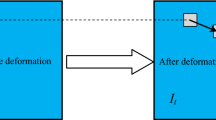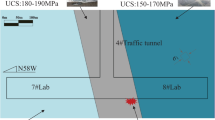Abstract
In this paper, a physical model experiment was conducted to study the deformation and failure mechanism of surrounding rock of deep-buried soft tunnel. With the help of noncontact displacement monitoring system, strain data acquisition system, and high-definition camera, the displacement field data, the strain field data, and the deformation and failure process of surrounding rock were obtained during the experiment. The results of study showed that the excavation footage and horizontal stress had a significant influence on the deformation of surrounding rock of deep-buried soft rock tunnel; the surrounding rock had obvious asymmetrical deformation, and the key position of failure was located at the top and right side of tunnel; the uncoordinated deformation areas were the potential dangerous destruction areas of surrounding rock; and the surrounding rock of tunnel was destroyed under the combined action of tension and compression stress.














Similar content being viewed by others
References
Bobet A (2009) Elastic solution for deep tunnels. Application to excavation damage zone and rockbolt support. Rock Mech Rock Eng 42(2):147–174
Chen GQ, Feng XT, Zhang CQ et al (2008) Research on prevention measures for failure induced by tunneling in deep hard rock. Chin J Rock Mech Eng 27(10):2064–2071 (in Chinese)
Chen M, Lu WB, Yan P et al (2016) Blasting excavation induced damage of surrounding rock masses in deep-buried tunnels. KSCE J Civ Eng 20(2):933–942
Gong WL, Gong YX, Long YF (2013a) Multi-filter analysis of infrared images from the excavation experiment in horizontally stratified rock. Infrared Phys Technol 56:57–68
Gong WL, Wang J, Gong YX, Guo PY (2013b) Thermography analysis of a roadway excavation experiment in 60° inclined stratified rocks. Int J Rock Mech Min Sci 60:134–147
Gong WL, Peng YY, Sun XM, He MC (2015a) Enhancement of low-contrast thermograms for detecting the stressed tunnel in horizontally stratified rocks. Int J Rock Mech Min Sci 74:69–80
Gong WL, Peng YY, He MC, Wang J (2015b) Physical modeling of deep ground excavation in geologically horizontally strata based on infrared thermography. Tunn Undergr Space Technol 49:156–173
Guo QL, Wu FQ, Qian WP et al (2006) Study on relationship between deformation of surrounding rock and in-situ stress in Wushaoling deep-buried railway tunnel. Chin J Rock Mech Eng 25(11):2194–2199 (in Chinese)
He MC (2011) Physical modeling of an underground roadway excavation in geologically 45 inclined rock using infrared thermography. Eng Geol 121:165–176
He MC, Gong WL, Li DJ, Zhai HM (2009) Physical modeling of failure process of the excavation in horizontal strata based on IR thermography. Min Sci Technol 19(6):689–0698
He MC, Jia XN, Gong WL, Lohrasb F (2010a) Physical modeling of an underground roadway excavation in vertically stratified rock using infrared thermography. Int J Rock Mech Min Sci 47:1212–1221
He MC, Gong WL, Zhai HM, Zhang HP (2010b) Physical modeling of deep ground excavation in geologically horizontally strata based on infrared thermography. Tunn Undergr Space Technol 25(4):366–376
Lee YZ, Schubert W (2008) Determination of the length for tunnel excavation in weak rock. Tunn Undergr Space Technol 23(3):221–231
Lei MF, Lin DY, Yang WC et al (2016) Model test to investigate failure mechanism and loading characteristics of shallow-bias tunnels with small clear distance. J Cent South Univ 23(12):3312–3321
Li SJ, Feng XT, Li ZH et al (2012) Evolution of fractures in the excavation damaged zone of a deeply buried tunnel during TBM construction. Int J Rock Mech Min Sci 55:125–138
Li XP, Zhao H, Wang B et al (2013) Mechanical properties of deep-buried marble material under loading and unloading tests. J Wuhan Univ Technol 28(3):514–520 (in Chinese)
Lin P, Liu HY, Zhou WY (2015) Experimental study on failure behaviour of deep tunnels under high in-situ stresses. Tunn Undergr Space Technol 46:28–45
Meguid MA, Saada O, Nunes MA et al (2008) Physical modeling of tunnels in soft ground: a review. Tunn Undergr Space Technol 23(2):185–198
Meng LB, Li TB, Jiang Y et al (2013) Characteristics and mechanisms of large deformation in the Zhegu mountain tunnel on the Sichuan–Tibet highway. Tunn Undergr Space Technol 37:157–164
Sun XM, Chen F, He MC, Gong WL, Xu HC, Lu H (2017a) Physical modeling of floor heave for the deep-buried roadway excavated in ten degree inclined strata using infrared thermal imaging technology. Tunn Undergr Space Technol 47:52–63
Sun XM, Xu HC, He MC, Zhang F (2017b) Experimental investigation of the occurrence of rockburst in a rock specimen through infrared thermography and acoustic emission. Int J Rock Mech Min Sci 93:250–259
Sun XM, Chen F, Miao CY, Song P et al (2018) Physical modeling of deformation failure mechanism of surrounding rocks for the deep-buried tunnel in soft rock strata during the excavation. Tunn Undergr Space Technol 74:247–261
Xie LX, Lu WB, Zhang QB et al (2016) Damage evolution mechanisms of rock in deep tunnels induced by cut blasting. Tunn Undergr Space Technol 58:257–270
Xiong LX, Yang LD (2009) Stress evolution of deep cavern induced by excavating. J Cent S Univ Technol (Sci and Technol) 40(1):236–242 (in Chinese)
Yan P, Lu WB, Chen M et al (2015) Contributions of in-situ stress transient redistribution to blasting excavation damage zone of deep tunnels. Rock Mech Rock Eng 48(2):715–726
Yang SQ, Xu P, Ranjith PG, Chen GF, Jing HW (2015a) Evaluation of creep mechanical behavior of deep-buried marble under triaxial cyclic loading. Arab J Geosci 8(9):6567–6582
Yang JH, Lu WB, Hu YG et al (2015b) Numerical simulation of rock mass damage evolution during deep-buried tunnel excavation by drill and blast. Rock Mech Rock Eng 48(5):2045–2059
Yang JH, Jiang QH, Zhang QB et al (2018) Dynamic stress adjustment and rock damage during blasting excavation in a deep-buried circular tunnel. Tunn Undergr Space Technol 71:591–604
Zareifard MR, Fahimifar A (2016) Analytical solutions for the stresses and deformations of deep tunnels in an elastic-brittle-plastic rock mass considering the damaged zone. Tunn Undergr Space Technol 58:186–196
Zhang CQ, Zhang Y et al (2017) Analysis on deformation characteristic of surrounding rock mass in deep tunnel buried in the hard and soft coexistence formation and coping strategy for construction risk. Chin J Rock Mech Eng 13(4):1040–1046 (in Chinese)
Zhao Y, Zhang ZG (2015) Mechanical response features and failure process of soft surrounding rock around deeply buried three-centered arch tunnel. J Cent South Univ 22(10):4064–4073
Zhu WS, Zhang QB, Zhu HH et al (2010) Large-scale geomechanical model testing of an underground cavern group in a true three-dimensional (3-D) stress state. Can Geotech J 47(9):935–946
Zhu WC, Wei J, Zhao J et al (2014) 2D numerical simulation on excavation damaged zone induced by dynamic stress redistribution. Tunn Undergr Space Technol 43:315–326
Acknowledgements
The authors of this paper are very grateful to the reviewers for their valuable and pertinent suggestions for the revision of this article, and also to the support and help of their families.
Funding
This work was supported by the National Key Research and Development Plan of China (Grant No. 2016YFC0600901), the National Natural Science Foundation of China (Grant No. 51374214), the State Key Laboratory of Open Funds (Grant No. SKLGDUEK1826), the Special Fund of Basic Research and Operating (Grant No. 2009QL03), and the Yueqi Outstanding Scholar Award Program of China University of Mining and Technology, Beijing, and the Science and Technology Projects Funds of State Grid Corporation Headquarters of China.
Author information
Authors and Affiliations
Corresponding author
Rights and permissions
About this article
Cite this article
Sun, X., Song, P., Zhao, C. et al. Physical modeling experimental study on failure mechanism of surrounding rock of deep-buried soft tunnel based on digital image correlation technology. Arab J Geosci 11, 624 (2018). https://doi.org/10.1007/s12517-018-3979-3
Received:
Accepted:
Published:
DOI: https://doi.org/10.1007/s12517-018-3979-3




